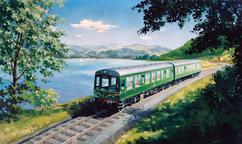

Two portraits, George Turnbull’s palki bearer and an untitled portrait
- Made:
- 1852
- maker:
- Slater, J, J




Drawings, two, pastel. On the obverse is G T's bearer and on the reverse is a portrait of a man in Indian dress, both by J Slater, 1852. The portrait of George Turnbull's bearer depicts a moustachioed man in Indian dress, seen from the waist up, with his arms folded. Below is the title, in pencil, and at bottom right the words "J Slater fecit, 1852". At bottom left is the number 33. On the reverse is a portrait of an older, bearded man in Indian dress, seen in profile. This work is untitled but it appears to be by Slater. The number 8 appears at top right. Unframed, with the corners cut off. From the collection of George Turnbull, Chief Engineer of the East Indian Railway. The inscriptions are in Turnbull’s hand.
The first of these two portraits depicts one of George Turnbull’s palki bearers, or palki-wallahs (wallah is a Hindi suffix for a person employed to do a particular thing). A palki or palanquin is a covered wheelless vehicle consisting of a large box carried on two horizontal poles. Passengers sat inside the box and were carried by four or six bearers. When on long trips, palkis served as improvised on-the-road accommodation, with passengers sleeping inside the box. A similar system of horizontal poles called a banghy was used to carry luggage and parcels. Palkis and banghies required lots of labour. For example, Turnbull took a trip to Darjeeling in 1861 with his wife Fanny, his two children, their Ayah (nanny), and a nurse named Mrs Dyson. The group of 6 was accompanied by 40 men (26 Sahibgunge men and sixteen Talgeria men), who served as palki- and banghy-wallahs. This racialised labour hierarchy—brown men carrying white people—was common in colonial India. The drawing’s inscription reflects the power dynamic of this labour: the palki-wallah is not named, he is instead referred to only by his job.
On the reverse is a second portrait. The identity of the sitter is not inscribed and currently not known. Given the similarities in clothing, it is perhaps another palki- or banghy-wallah.
The drawings’ artist, J. Slater, is most likely the same Slater that served as an engineer and surveyor for the East Indian Railway (as reported in the Morning Post, Thursday 9 September 1847). Slater had already been in India for some time prior to 1847, and he accompanied Turnbull on many of his surveying excursions during 1850, helping him assess the best route for the line.
These are not the only drawings Slater made. In his autobiography Turnbull wrote of acquiring ‘Slater’s likeness’ of a ‘Captain Boscawen’, adding that ‘it is a very good’ likeness (July 1850). The whereabouts of this portrait is no longer known.
In 1851 Turnbull noted that Slater was exhibiting symptoms of pulmonary disease. Turnbull stayed at Slater’s residence in Howrah on 7 January 1852, which is perhaps when these drawings were made. Soon after, Slater’s symptoms worsened, and he sailed for London on 24 January on a leave of absence. He died shortly after arriving. These two drawings, dated 1852, are perhaps the final two he made.
Scottish engineer George Turnbull (1809-1889) oversaw the creation of one of the first railways in India, the East Indian Railway (EIR). Turnbull collected artworks during his time in India, many of which were produced by EIR engineers. These watercolours and drawings provide a rare view of nineteenth-century India from the perspective of the British engineers designing and building the country’s first railways. The collection includes landscape scenes and portraits. While many of the landscapes show the construction of the railway, others focus entirely on India’s local architecture or its rural spaces. The portraits are of people Turnbull encountered while in India. While the portraits of British people are inscribed with their names, most of the Indian people depicted remain anonymous or identified only by their job.
The British introduced railways in India to satisfy the mounting economic and military needs of their colonial administration. They hoped that the new technology would foster an increased sense of collective identity by making it easier to travel quickly between distant regions. They also hoped the railways would socially ‘improve India’ by instilling a sense of punctuality among Indians, a quality British colonialists believed Indians lacked. The racist stereotypes underpinning these intentions, and the interconnected idea that technology could trigger social change, were common beliefs in nineteenth-century British society.




